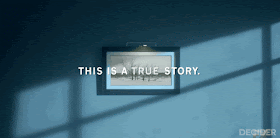When James Frey couldn’t sell his excellent story (A Million Little Pieces) as fiction, he
presented it as nonfiction and it sold with an explosive marketing campaign.
What followed was Oprah’s endorsement and NYT bestselling status until...
A website called The Smoking Gun exposed it as fictional,
after all.
Every story has some of the writer’s reality in it. But if
you label it non-fiction, you should stick very closely to documentable events. Where you take liberties, such as name changes to protect people or
omissions for the sake of expediency, you must acknowledge this right off the
bat.
Even when reading fiction, the reader wants it to be real.
We secretly think that though the writer states this is a work of fiction, it’s
*likely, mostly, basically, please-be* a true story.
This is why the how-to books admonish not to start a story with
a dream sequence or a flashback. A reader invests in what is happening, only to
find out it was just a dream or something that happened long before the main
narrative. Na-ah. Not nice. Don’t do it to them.
Readers want that “happening now” feel, an exclamatory
phrase CNN uses with abandon. It is much easier to sell a story if the
storyteller prefaces it with BASED ON A TRUE STORY.
Long ago, the sight of an old Victorian house in an adjacent
town inspired me to imagine a ghost story that could have occurred in it. Actually,
I based the story on something a friend told me did happen to the family that
lived there.
The next time I walked by with my kids, (then five and eight
years old) I told them the story. Don’t be alarmed, it was a kid-friendly version.
They were riveted.
{Full disclosure: photo is not that very house^ but one
very similar looking J}
Then the question came. “This I a true story. Right, Mom?”
The way they phrased the question begged me to lie. But they
were my kids, not some nameless unseen readers. I told the truth.
“Well, no. I made it up. But the house inspired it.”
The instant deflation of their spirits testified to how much
it mattered.
There are ways to sort of get around this.
Think of the lines that precede the first chapter of The Da Vinci Code. It’s a list of two little-known things that are factual, investing the reader in what is a work of fiction.
The Movie (and made for TV series) Fargo begins with “this is a true story,” but phrased in an enigmatic way that works as a disclaimer, too.
Think of the lines that precede the first chapter of The Da Vinci Code. It’s a list of two little-known things that are factual, investing the reader in what is a work of fiction.
The Movie (and made for TV series) Fargo begins with “this is a true story,” but phrased in an enigmatic way that works as a disclaimer, too.
Because if we are to follow a narrative we need to believe
it. At the very least, we need to have our incredulous nature suspended for the
duration.


Interesting post.
ReplyDeleteThere's a fine line between fiction and nonfiction. Thanks for this reminder.
ReplyDeleteI've never read his book, but from what I heard, all James Frey needed was a disclaimer at the beginning of the book (names have been changed to protect identities; some characters are based on multiple people; some incidents have been changed/exaggerated to make a point). Am I right or do I not understand what happened?
ReplyDeleteLove,
Janie
I believe Frey's book was largely fictional, but no one wanted to publish it as such. Most who write draw on interior states when imagining how characters feel or make choices, but that is not enough to call it "a true story," though it contains deep truths.
DeleteThanks for the information.
DeleteIt always amazes me that in TV and movies, people are willing to overlook that which isn't realistic or believable. But if a writer tries to do that... Eek! We are called out immediately. We have a tough job.
ReplyDeleteI've had that happen with one of my MG, when a couple of readers and an editor referred to it as "implausible." Only that story was closer to life (mine, family, and close friends') than most. If I were a different person, I might have sold it saying it was a true story :(
Delete